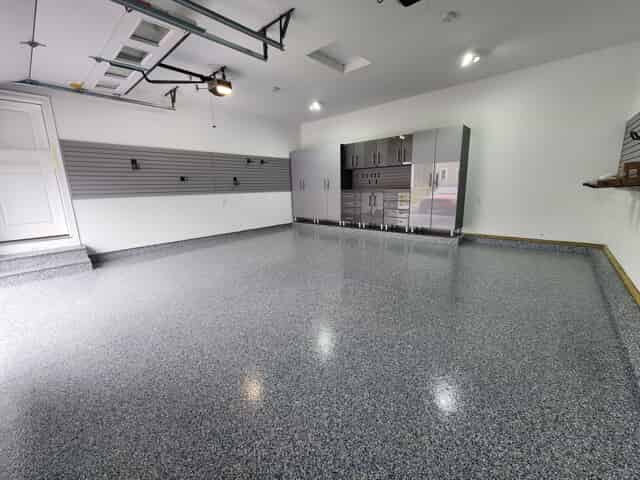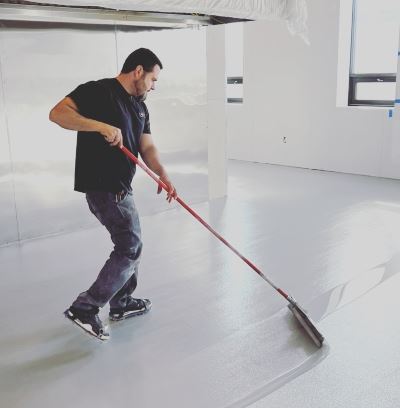In the realm of industrial, commercial and residential flooring, finding the perfect combination of coatings is crucial for achieving durability, aesthetics, and longevity. Among the many options available, a winning duo has emerged— epoxy basecoats and polyaspartic topcoats. This dynamic pairing not only enhances the visual appeal of surfaces but also provides a myriad of benefits, making it a top choice for a wide range of applications.

The Power of Epoxy Basecoats:
Epoxy has long been a stalwart in the world of flooring, selected for its exceptional adhesion and strength. When used as a basecoat, epoxy provides a solid foundation that bonds to the substrate, creating a resilient surface that withstands heavy traffic, impacts, and chemical exposure. Here are some key benefits of epoxy basecoats:
- Superior Adhesion: Epoxy adheres exceptionally well to various substrates, ensuring a strong bond that is crucial for the longevity of the flooring system.
- Chemical Resistance: Epoxy is highly resistant to chemicals, making it an ideal choice for environments where exposure to corrosive substances is a concern, such as manufacturing facilities and laboratories.
- Durability: The robust nature of epoxy provides a durable foundation that can withstand the rigors of daily use, making it perfect for high-traffic areas.
The Brilliance of Polyaspartic Topcoats:

While epoxy sets the stage with its strength and adhesion, polyaspartic topcoats take the spotlight for their rapid curing, UV resistance, and superior scratch protection. Here's why polyaspartic topcoats are the perfect finishing touch:
- Chemical Resistance: Polyaspartic coatings are highly resistant to a wide range of chemicals, including alkalis, solvents, and oils. This chemical resistance is vital in environments where exposure to harsh substances is common, such as laboratories, manufacturing plants, food processing facilities, and automotive service areas.The molecular structure of polyaspartic coatings forms a protective barrier that shields the underlying substrate from chemical penetration and degradation. This resistance not only preserves the integrity of the coating but also ensures the longevity of the entire flooring system. It makes polyaspartic coatings an excellent choice for areas where spills and chemical exposure are likely to occur regularly.
- Abrasion and Scratch Resistance: Polyaspartic coatings exhibit high resistance to abrasion, making them suitable for areas with heavy foot traffic, vehicular traffic, or other abrasive forces. This resistance is attributed to the molecular structure of polyaspartic coatings, which forms a tough and resilient surface. This characteristic is particularly beneficial in environments such as warehouses, garages, manufacturing facilities, and commercial spaces where the floor is subjected to constant wear and tear.
- UV Stability: Unlike some traditional coatings that may yellow or degrade when exposed to sunlight, polyaspartic topcoats maintain their clarity and color stability over time, thanks to their excellent UV resistance.
- Enhanced Aesthetics: Polyaspartic coatings provide a glossy finish that enhances the visual appeal of the flooring. This not only adds a touch of sophistication but also makes maintenance easier, as dirt and stains are less likely to adhere to the smooth surface. The chemical resistance of polyaspartic coatings simplifies cleaning and maintenance. Spills can be easily wiped away without causing damage to the coating, maintaining a clean and safe environment.
Explaining the dangers of using Polyaspartic as a Base Coat
While the idea of getting your garage floor installed in a day with a “Full polyaspartic” system is alluring, it is essential to acknowledge the drawbacks and risks when using polyaspartic as a base coat and opting for one-day systems.
- Limited Thickness: Polyaspartic coatings are known for their rapid curing, which is a significant advantage in terms of project timelines. However, this characteristic can also be a drawback when used as a base coat. The quick curing time limits the thickness of the coating that can be applied in a single layer. This may impact the overall build and structural integrity of the flooring system.
- Adhesion Challenges: While polyaspartic coatings generally exhibit excellent adhesion to properly prepared surfaces, achieving a strong bond with certain substrates or existing coatings might pose challenges. The fast curing time leaves a narrow window for the coating to penetrate and adhere effectively, increasing the risk of adhesion issues.
- Temperature Sensitivity: Polyaspartic coatings can be sensitive to temperature variations and relative humidity during application. In extreme temperatures, the coating may cure too quickly or not bond effectively, leading to a compromised base coat. Careful consideration and control of environmental conditions are crucial when working with polyaspartic coatings, especially in one-day systems.
- Surface Preparation Complexity: Achieving optimal results with polyaspartic as a base coat requires meticulous surface preparation. Any contaminants or imperfections on the substrate can negatively impact adhesion and overall performance. In one-day systems, the pressure to complete the entire flooring installation in a short timeframe may compromise the thoroughness of surface preparation.
- Limited Correction Time: One-day systems are designed for rapid turnaround, leaving little room for error. If an issue arises during application or curing, there is limited time for correction. This lack of flexibility can be a significant drawback, especially in complex installations or when facing unexpected challenges especially in New England when we have older, imperfect floors, this is a practical problem in a majority of homes
- Potential for Application Mistakes: The speed of one-day systems can lead to rushed application processes. This increases the likelihood of mistakes such as uneven coating thickness, bubbles, or debris getting trapped in the coating. These application errors can compromise the aesthetics and performance of the flooring system.
The Winning Combination:
When these two powerhouses—epoxy basecoats and polyaspartic topcoats—are combined, they create a flooring system that is greater than the sum of its parts. The epoxy base provides a solid and resilient foundation, while the polyaspartic topcoat adds the finishing touch of beauty, rapid curing, and extended durability.
Conclusion:
The benefits of using epoxy as basecoats and polyaspartic as a topcoat(s) are clear—this winning combination delivers a flooring solution that excels in strength, chemical resistance, aesthetics, and longevity. Whether in a commercial setting, industrial facility, or residential space, this dynamic duo is paving the way for a new standard in high-performance flooring systems.
